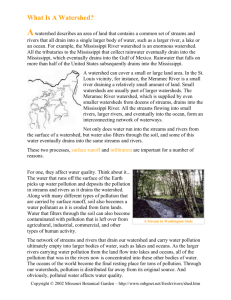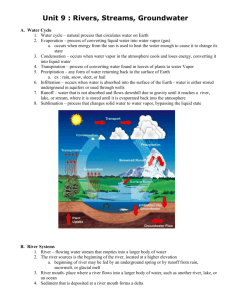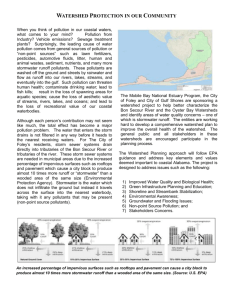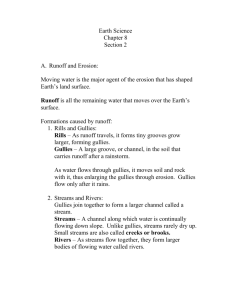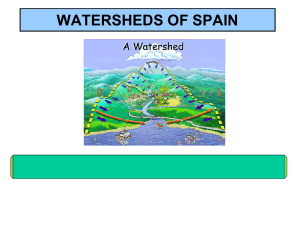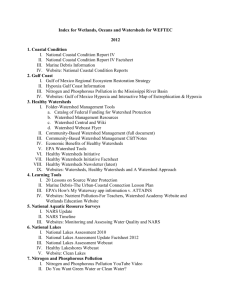Watersheds and the Land Notes
advertisement
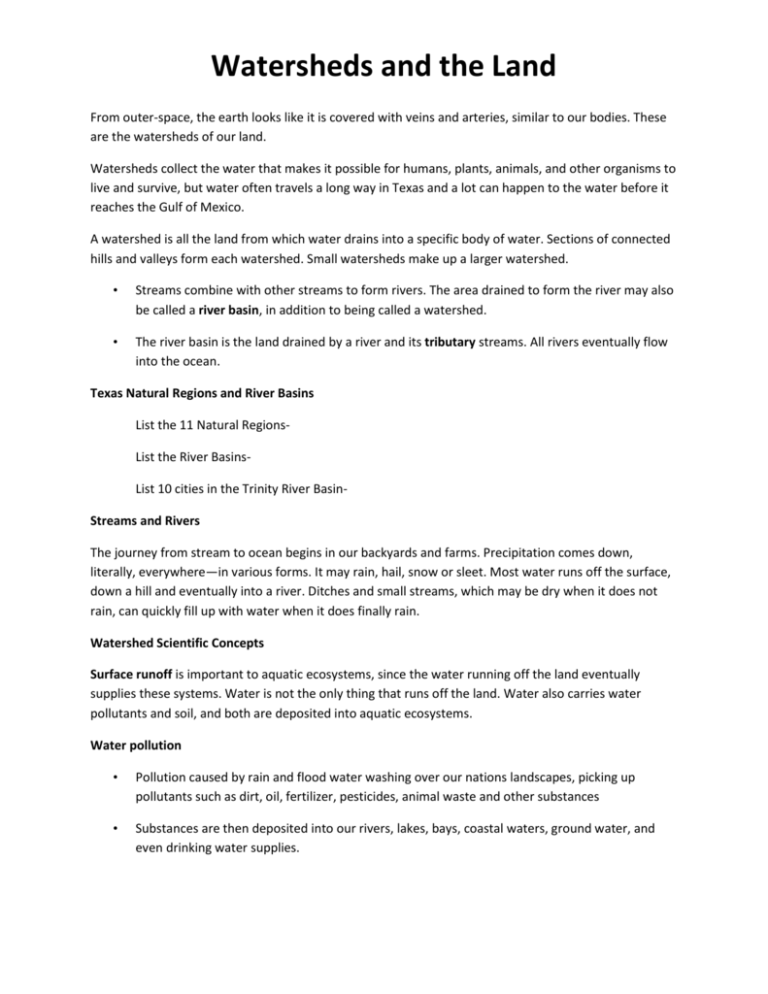
Watersheds and the Land From outer-space, the earth looks like it is covered with veins and arteries, similar to our bodies. These are the watersheds of our land. Watersheds collect the water that makes it possible for humans, plants, animals, and other organisms to live and survive, but water often travels a long way in Texas and a lot can happen to the water before it reaches the Gulf of Mexico. A watershed is all the land from which water drains into a specific body of water. Sections of connected hills and valleys form each watershed. Small watersheds make up a larger watershed. • Streams combine with other streams to form rivers. The area drained to form the river may also be called a river basin, in addition to being called a watershed. • The river basin is the land drained by a river and its tributary streams. All rivers eventually flow into the ocean. Texas Natural Regions and River Basins List the 11 Natural RegionsList the River BasinsList 10 cities in the Trinity River BasinStreams and Rivers The journey from stream to ocean begins in our backyards and farms. Precipitation comes down, literally, everywhere—in various forms. It may rain, hail, snow or sleet. Most water runs off the surface, down a hill and eventually into a river. Ditches and small streams, which may be dry when it does not rain, can quickly fill up with water when it does finally rain. Watershed Scientific Concepts Surface runoff is important to aquatic ecosystems, since the water running off the land eventually supplies these systems. Water is not the only thing that runs off the land. Water also carries water pollutants and soil, and both are deposited into aquatic ecosystems. Water pollution • Pollution caused by rain and flood water washing over our nations landscapes, picking up pollutants such as dirt, oil, fertilizer, pesticides, animal waste and other substances • Substances are then deposited into our rivers, lakes, bays, coastal waters, ground water, and even drinking water supplies. Watersheds and the Land • Point-source pollution is contamination that can be traced to a single source. For example: Point source pollution comes from a single source that people can identify (or point to), such as a pipe connected to a specific place. • Non-point source pollution comes from a broad area or a number of sources. For example: runoff from fields and construction areas, fertilizers used on lawns and golf courses, fuel, oil and antifreeze from roads, and animal waste and bacteria from feedlots. Erosion and Sedimentation • Erosion is the wearing away and movement of solid material such as rock, soil, or mud. It is a natural process caused by the forces of wind, water, ice, gravity, and/or living things. • Sedimentation is the process in which material (such as stones and sand) is carried to the bottom of a body of water and forms a solid layer Negative Effects of Erosion • Sedimentation from runoff clouds the water, reduces the amount of sunlight reaching aquatic plants; covers fish spawning areas and food supplies; and clogs the gills of fish. • Runoff from animal facilities carries pathogens (bacteria and viruses), nutrients, and oxygendemanding substances that contaminate fish and cause other major water quality problems. • Pesticides, herbicides, and fungicides can enter and contaminate water through direct application, runoff, and wind transport. • These contaminates can kill fish and wildlife, poison food sources, and destroy the habitat that animals use for protective cover. • Erosion can be accelerated by cutting down too many trees, poor grazing practices, or disturbing land for construction. Planting trees and placing erosion controls along streams and rivers are two ways to slow the effects of erosion. Negative Effects of Sedimentation • The biggest pollutant of Texas’ waters is plain old dirt from sedimentation Erosion allows sediments to run into aquatic habitats causing deposits in streams and filling reservoirs and can make it difficult for aquatic organisms to get enough light and oxygen to survive. Watershed Scientific Concepts Not all water runs off the surface of the land. Some of the water soaks into the ground through the soil and underlying rock layers—a process known as infiltration. When infiltration occurs, some of the water returns to the surface, while the rest remains below as groundwater.

